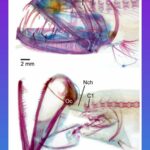Have you ever stopped to consider how some animals manage to secure their next meal? It’s not always a matter of brute force or lightning-fast speed. Some creatures are masters of disguise, employing cunning strategies to lure unsuspecting prey directly into their clutches. These are the architects of mimicry – animals that transform their appearance to resemble something else entirely, all for the sake of a delectable dinner. From insects masquerading as delicate blossoms to fish wielding bioluminescent lures, we’re about to embark on a journey to explore the extraordinary world of deceptive predators and their mastery of illusion.
Deceptive Strategies: Exploring Animal Mimicry for Attack
The natural world is replete with surprises, and some of the most astonishing are the creatures who rely on trickery as their primary means of survival. These aren’t simply your average predators; they are skilled illusionists, employing mimicry with lethal precision. Join us as we delve into the captivating realm of animals that wield deception as their ultimate weapon, scrutinizing their sophisticated camouflage techniques and intricate predatory behaviors.
-
The Orchid Mantis: The Flower That Conceals a Predator: Envision a breathtaking orchid, its petals radiating vibrant hues and beckoning with irresistible allure. However, this is no ordinary flower; it’s a cunning predator in disguise! The orchid mantis stands as a quintessential example of aggressive mimicry. Resembling the orchids that constitute its habitat, it seamlessly merges into its surroundings, rendering itself virtually undetectable. This ingenious camouflage serves as a magnet for unsuspecting pollinators, such as bees and butterflies, who venture in for a closer examination, unwittingly signing their own death warrants. With unwavering patience, the mantis lies in wait, poised to unleash its lightning-fast reflexes upon its hapless prey. This remarkable adaptation underscores the remarkable capacity of animals to leverage deception for survival, showcasing the power of evolutionary adaptations. While scientists universally acknowledge the effectiveness of this strategy, accurately quantifying its success rate has proven to be an intricate endeavor.
-
Anglerfish: The Deep-Sea Illusionist with a Bioluminescent Lure: Now, let us descend into the abyssal depths of the ocean, where perpetual darkness reigns supreme. Here, in the inky blackness where sunlight struggles to penetrate, dwells the anglerfish. This bizarre and enigmatic creature possesses a bioluminescent lure – a luminous fishing rod, if you will – that dangles seductively in front of its gaping maw. Smaller fish, irresistibly drawn to the enticing glow, swim closer, only to be engulfed in a swift and decisive strike. This macabre ballet of light and shadow epitomizes the remarkable power of bioluminescence in attracting prey in the deep, dark ocean. While the efficacy of this predatory technique is well-established, the precise success rate remains a subject of ongoing investigation. Some researchers hypothesize that the lure’s effectiveness may fluctuate based on the density of prey inhabiting a particular area, underscoring the diversity of hunting strategies employed by the anglerfish.
-
The Mimic Octopus: The Master of Metamorphosis: Allow us to introduce the mimic octopus, an absolute virtuoso of disguise! This extraordinary cephalopod possesses an unparalleled ability: it can rapidly alter its appearance to emulate a plethora of other marine creatures. In the blink of an eye, it can transform into a venomous sea snake, then morph into a formidable lionfish, or even flatten its body to resemble a nondescript flounder. This remarkable feat transcends mere parlor tricks; it’s a pivotal survival strategy honed through eons of natural selection. By impersonating dangerous animals, the mimic octopus effectively deters potential predators, safeguarding its own existence. This represents a breathtaking example of Batesian mimicry – a form of mimicry wherein a harmless creature imitates a dangerous one – elevated to an unparalleled level of sophistication. The intricacies of this mimicry are under intense scrutiny, with scientists striving to decipher the extent of control the octopus wields over its transformations and the degree to which each mimicry contributes to its ultimate survival, thereby influencing animal behavior.
-
The False Cleanerfish: A Con Artist of the Coral Reef: Venture into the vibrant tapestry of a coral reef, a bustling underwater metropolis teeming with life in all its resplendent forms. Here, you will encounter the false cleanerfish, a deceptive dentist of the deep. This cunning imposter meticulously replicates the appearance of genuine cleanerfish, which provide a mutually beneficial service to other fish by removing parasites from their bodies. Lured by the promise of a thorough cleaning, other fish approach the false cleanerfish, placing their trust in what appears to be a benevolent ally. However, this “cleaner” is nothing more than a seasoned con artist! Instead of diligently removing parasites, it seizes the opportunity to surreptitiously nip at the fins of its unsuspecting clients. This represents a striking example of aggressive mimicry, where a predator imitates a harmless species to entice its prey. The long-term ramifications of this deceptive strategy on the coral reef ecosystem are an area of intensive ongoing research. Some experts posit that it could exert a profound influence on the delicate balance of species within the reef, highlighting the intricate dynamics of the coral reef ecosystem.
-
Deception: A Potent Evolutionary Force: These examples represent only a fraction of the diverse array of animals that rely on deception as a primary survival mechanism. The sheer diversity of strategies employed underscores the transformative power of natural selection. The perpetual “evolutionary arms race” between predator and prey fuels the continuous development of novel and ingenious camouflage and mimicry techniques. While we can readily observe these deceptive behaviors in action, precisely quantifying the success rates of each strategy remains a significant challenge for future research endeavors. This underscores the ever-evolving and intricate nature of the animal kingdom, a world where even the most diminutive creature can possess remarkable abilities. The study of mimicry represents a captivating field that promises to unveil further insights into the ingenious ways in which animals interact with their environment, profoundly influencing species survival. Is it not truly awe-inspiring how these creatures have adapted and evolved? There remains a vast expanse of knowledge to be gleaned, and future studies are poised to reveal even more astonishing facets of these masters of illusion.
Evaluating the Success of Animal Deception Strategies in the Wild
Key Takeaways:
- Deception stands as a prevalent survival tactic within the animal kingdom, employed for diverse purposes such as hunting, evading predators, and attracting mates.
- The effectiveness of these strategies is subject to considerable variation, contingent upon factors such as predator intelligence and environmental conditions. Quantifying success rates remains an imposing challenge.
- A broad spectrum of species employs deception, underscoring its profound evolutionary significance.
- Comprehending these deceptive strategies yields invaluable insights into animal behavior, ecology, and evolutionary biology, as well as the implications of predator-prey relationships.
Masters of Disguise: Camouflage and Mimicry
Numerous animals rely on camouflage to seamlessly integrate into their surroundings, blurring the lines of distinction between themselves and their environment. Consider the chameleon, capable of altering its coloration to perfectly match its backdrop, or the leaf insect, which flawlessly replicates the appearance of a verdant leaf. How successful are animal deception strategies in the wild that are rooted in camouflage? The answer lies in its efficacy in enabling the animal to remain undetected by both predators and prey alike. However, the equation changes dramatically when a predator’s eyesight is enhanced or a prey’s awareness is heightened, as these factors can significantly compromise the effectiveness of camouflage.
Mimicry elevates deceptive tactics to an entirely new plane of sophistication. Certain animals mimic other organisms to secure a survival advantage. The viceroy butterfly, for instance, imitates the toxic monarch butterfly, effectively dissuading predators from targeting it. Similarly, some harmless insects mimic stinging wasps, deterring potential attackers from engaging in confrontation. The success of mimicry hinges on the effectiveness of the disguise and its capacity to convincingly deceive the predator or prey, leading to a pivotal question concerning its impact on populations.
Aggressive Mimicry: The Ultimate Decoy
Aggressive mimicry is where the intricacies of deception reach their zenith. In this scenario, predators employ deception to lure unsuspecting prey within striking distance. The anglerfish, with its bioluminescent lure, serves as a prime exemplar of this strategy. This lure serves as an irresistible beacon for smaller fish, only to lead them to their ultimate demise. Likewise, the orchid mantis flawlessly mimics a flower, enticing pollinators to their impending doom as they unwittingly become its next meal. How successful are animal deception strategies in the wild that harness the power of aggressive mimicry? Studies have revealed a high success rate among ambush predators, yet it is crucial to acknowledge that environmental factors and prey intelligence exert a significant influence on the overall outcome.
Tactical Deception: Beyond Camouflage
Beyond the realm of simple mimicry and camouflage, certain animals engage in more complex forms of deception that showcase their cognitive prowess. The cuttlefish, a veritable master of disguise, boasts the remarkable ability to rapidly alter its skin texture and color to seamlessly blend into its environment, evade predators, or even communicate with its conspecifics. Some avian species employ deceptive vocalizations to entice other birds to their nests, whereupon they proceed to pilfer their food or eggs. These sophisticated strategies hint at a complex level of awareness and planning, but once again, the fundamental question arises: how successful are animal deception strategies in the wild that exhibit such intricate behavioral patterns? Answering this question requires quantifiable, long-term observations of behavioral patterns conducted within their natural habitat.
The Evolutionary Arms Race
The prevalence of animal deception underscores the existence of an enduring evolutionary arms race that shapes the relationships between predators and prey. As predators refine their detection methods, prey must, in turn, evolve more sophisticated deceptive tactics to evade capture. The outcome is an incessant cycle of adaptation and counter-adaptation, driving the incredible diversity of deceptive strategies witnessed throughout the natural world. Further research is imperative to fully unravel the intricacies of this evolutionary dance and ascertain the long-term success of these strategies, which could exert a profound influence on the future evolution of these species.
Deceptive Masters: Evolutionary Arms Race: Exploring Predator-Prey Dynamics in Animal Deception
Key Takeaways:
- Animals have undergone a remarkable evolutionary trajectory, acquiring astounding mimicry skills that bolster their prospects for survival.
- These deceptive tactics are integral to the Evolutionary Arms Race: Predator-Prey Dynamics in Animal Deception, which underscores the ongoing struggle between predators and their targets.
- Mimicry encompasses the dual objectives of attracting prey and evading predators, showcasing its versatility as a survival mechanism.
- Precisely quantifying the success rates of these deceptive strategies remains a challenge, necessitating further investigation.
The Orchid Mantis: A Floral Deception
Visualize a mantis, impeccably camouflaged as a flower, its form indistinguishable from the surrounding blossoms. The orchid mantis exemplifies this remarkable adaptation, patiently awaiting its quarry while seamlessly merging with its environment. Unsuspecting insects, lured by the vibrant “petals,” unwittingly venture into the predator’s domain, only to become its next repast. This is aggressive mimicry in its quintessential form, wherein a predator impersonates its prey to entice them within striking distance. The mantis’s survival hinges on its capacity to deceive its prey, which, in turn, propels the prey’s evolutionary journey toward enhanced detection capabilities.
The Anglerfish: Luring with Light
Venturing into the abyssal realm of the ocean’s darkness, the anglerfish employs an alternative yet equally effective strategy. A bioluminescent lure, suspended enticingly before its maw, serves as a beacon for smaller fish, attracting them with irresistible allure. Upon their approach, the anglerfish executes a swift and decisive strike, demonstrating the potency of deception in a low-light environment. The effectiveness of this tactic is intrinsically linked to the visibility of the lure and the vulnerability of the prey. This scenario epitomizes the Evolutionary Arms Race: Predator-Prey Dynamics in Animal Deception, underscoring the co-evolutionary trajectory of predator and prey, as both entities refine their strategies over vast timescales.
The Viceroy Butterfly: A Clever Copycat
The viceroy butterfly exhibits a remarkable feat of mimicry, flawlessly replicating the appearance of the toxic monarch butterfly. Predators, having learned to shun the poisonous monarch, instinctively steer clear of the viceroy as well, effectively safeguarding the latter from predation. This represents Batesian mimicry, wherein a harmless species mimics a dangerous one to deter potential attackers. The Evolutionary Arms Race: Predator-Prey Dynamics in Animal Deception is in constant flux; any deviation from the monarch’s appearance could spell doom for the viceroy butterfly.
The Stick Insect: Master of Camouflage
Exhibiting exceptional camouflage capabilities, stick insects seamlessly blend with the twigs and branches of their arboreal habitat, rendering themselves virtually undetectable. Their disguise offers protection from a wide spectrum of predators, showcasing the power of natural selection in shaping survival strategies. The effectiveness of this strategy hinges not solely on visual mimicry but also on behavior—remaining motionless and averting any sudden movements that could betray their presence. Their success underscores the pivotal role of environment and behavior in the Evolutionary Arms Race: Predator-Prey Dynamics in Animal Deception.
Animal Deception in Diverse Habitats: A Comparative Study
Key Takeaways:
- Animal deception, encompassing a diverse array of tactics such as camouflage, mimicry, and strategic misdirection, represents a widespread survival mechanism in the natural world.
- Diverse deceptive methods exist, spanning visual, auditory, olfactory, and behavioral strategies, each tailored to specific ecological contexts.
- Deception effectiveness is subject to considerable variation, contingent upon habitat characteristics and predator-prey dynamics.
- While certain instances of deception appear to be instinctive, others intimate higher cognitive abilities, underscoring the complexity of animal behavior.
- Further research is warranted to quantify deception success rates and elucidate the role of consciousness in shaping these intricate strategies.
Masters of Disguise: Visual Deception
Imagine a world where appearances are deceptive, a world ruled by illusion and subterfuge. Many animals are masters of visual deception, honing their capabilities to deceive both predators and prey alike. Consider the orchid mantis, a stunning example of Animal Deception in Diverse Habitats: A Comparative Study at its finest. Its remarkable appearance mimics that of an orchid flower, luring unsuspecting pollinators to their impending doom as they unwittingly become its next meal. This is aggressive mimicry in its purest form. But what is the extent of its effectiveness? While we readily observe and document this behavior, precise quantification of its success remains an elusive pursuit.
The anglerfish, with its bioluminescent lure, employs a profoundly different visual strategy, harnessing the power of light to deceive its prey. This denizen of the deep sea utilizes a glowing appendage to attract unsuspecting victims, exemplifying the allure and ambush strategy. The striking contrast of light against the backdrop of perpetual darkness renders this deception highly effective, enticing prey to their peril. While the effectiveness is undeniable, achieving precise success metrics in this challenging environment represents a considerable undertaking.
Sounds of Deception: Auditory Illusions
Deception transcends the realm of visual perception, extending also to the realm of auditory illusions. Consider the drongo bird, a notorious mimic renowned for its replication of the alarm calls of other species. This clever tactic serves to distract potential prey, enabling the drongo to steal their food with impunity. Given the impact of alarm calls on animal behavior, this audacious behavior underscores the profound influence of deception in shaping ecological relationships. However, repeated deployment of this deception could potentially render it ineffective over time, compelling the drongo to continuously refine its techniques to maintain its edge.
Beyond Sight and Sound: Other Deceptive Strategies
The repertory of animal deception far surpasses mere visual and auditory displays, encompassing a wide array of olfactory and behavioral strategies that underscore the resourcefulness of the animal kingdom. The Gaboon viper, a master of camouflage, seamlessly merges into its environment, lying in wait for unsuspecting prey to wander within striking distance. This passive form of deception is equally effective, allowing the viper to ambush its victims with lethal precision. And what of the hognose snake’s dramatic feigning of death? This behavioral deception, often accompanied by a foul odor, serves to dissuade potential predators from initiating an attack, enhancing the snake’s prospects for survival.
This Animal Deception in Diverse Habitats: A Comparative Study illustrates that deception is a potent survival tool, and reinforces the success of mimicry, and demonstrates that different strategies are favored by different species, depending on the environmental context and the intricate dynamics of predator-prey relationships.
The Evolutionary Arms Race
The ceaseless struggle between deception and detection fuels the engine of evolution, driving the adaptation of both predators and prey. Predators are under constant selective pressure to evolve enhanced techniques for detecting deception, while prey, in turn, develop increasingly sophisticated deceptive strategies to evade capture. This dynamic interplay engenders a continuous cycle of innovation, with each side pushing the boundaries of adaptation in an ongoing quest for survival.
The Importance of Further Research
While qualitative evidence overwhelmingly suggests the effectiveness of animal deception, precise quantitative data remains limited, underscoring the imperative for further research. Future investigations should prioritize the gathering of empirical data to assess the true success rates of these strategies, and to elucidate the relationship between deception and ecosystem dynamics.
- Discover the Bristlecone Pine: Earth’s Oldest Living Organisms, a 5,000-Year Story of Resilience - August 2, 2025
- Understand the Dunning-Kruger Effect: Why Incompetent People Think They’re Experts: Gain Self-Awareness - August 1, 2025
- Ignaz Semmelweis: The Doctor Fired for Handwashing: A Public Health Tragedy - August 1, 2025
















